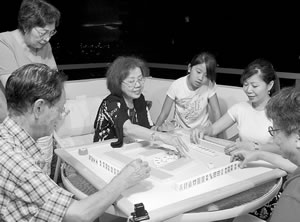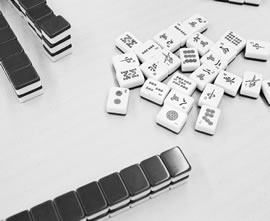Ah So ... The Ever-young Game Of Mah Jong
Once a week the loud clacking of Mah Jong tiles and chatter among friends are the loudest sounds heard in Kimi Lin’s Honolulu apartment. Lin and her friends Joannie Tam, Judy Liu, Carol Tsai and about five others gather to enjoy each other’s company, eat good homemade food and, of course, play Mah Jong until about midnight. It could be a Tuesday, Thursday, Friday or even a Saturday night, when the gamers gather.

|
Once a week the loud clacking of Mah Jong tiles and chatter among friends are the loudest sounds heard in Kimi Lin’s Honolulu apartment. Lin and her friends Joannie Tam, Judy Liu, Carol Tsai and about five others gather to enjoy each other’s company, eat good homemade food and, of course, play Mah Jong until about midnight.
It could be a Tuesday, Thursday, Friday or even a Saturday night, when the gamers gather. If they’re not at Lin’s home, they can be found at another friend’s in Pearl City - nothing stops these hardcore Mah Jong players. MidWeek caught up with this fun group on a recent Saturday.
“It’s to have something to continue the Chinese culture,” says Tam, whose 9-year-old daughter Vivian is also learning to play.
Tsai laughs, adding that “this is money, the reason they play,” as she points to the group’s pot of money chips by the two tables set up for the night’s games. The night’s winnings are divided up for first, second and third place.

“We all have our own (Mah Jong sets); all came from Taiwan,” Tsai continues.
Honolulu-based publicist Lisa Ontai, of Ontai-LaGrange and Associates, hung out at the recent game night. Ontai recalls that she was once pretty fast at the game.
“I used to be so sharp, played until I was 10 or 12. I got a Mah Jong set for Christmas (when she was a child),” says Ontai.
So how do you play this age old Chinese game? Four people are required to play, and groups can set up as many tables as they like, as long as there are enough sets of Mah Jong tiles. Each tile set has 144 total pieces, and each person builds a wall of 18 tiles, or “cards” as they’re sometimes called. The remaining pieces are placed in the middle, and each person goes around taking four pieces from this pile at the start of the game. One person is designated as the dealer. The game works kind of like the card game rummy, in which players attempt to get three of a kind, a sequence of cards of the same suit in numerical order, or four of a kind to win. In Mah Jong, players need to have four sets of three of a kind and one pair of tiles to win; you can also make sequences of tiles. Games go by rounds, with one game having four rounds.
There are also two types of Mah Jong: Taiwanese, which is played with 16 cards, and Cantonese, which is played with 13 cards. Tam says that Cantonese cards are larger and game rounds take longer.
“People from Hong Kong play Cantonese, people from Taiwan play Taiwanese,” explains Tam.
You don’t have to be Chinese to play Mah Jong -anybody can just go out and buy a set and learn the rules. However, the game is mostly passed down through generations of families. Here on Oahu, the Hawaii Chinese Association, of which Tam is president, helps introduce those without family members to teach them this beloved game at its yearly Splendor of China.

HCA past-president Neuman Pei originally started a Mah Jong booth at the event on his own, and the following year asked the association to take over running it. At this year’s “Splendor of China,” taking place on Saturday and Sunday at Blaisdell Exhibition Hall, tables will again be set up for all to try their hand at Mah Jong.
(**See the end of the story for details on “Splendor of China”)
Liu describes the game as being “very good for people who are seniors, (they) feel like all energy is up.”
Aside from the Mah Jong booth at the “Splendor of China,” there are many families and friends throughout the island who gather, as Lin and her friends do to play, but beyond this there are no formal gatherings, no tournaments or lessons and such.
“They’re probably happening in a gambling house,” jokes Tsai.
While there may not be formal Mah Jong gatherings locally, in New York the National Mah Jongg League organizes annual tourneys, as well as publishes newsletters and instruction books with the game’s traditional set of rules. The Ohio-based Wright-Patterson Officers’ Wives’ Club is also dedicated to following traditional rules. The group donates to charitable causes and has published a book on Mah Jong.
A brief history of Mah Jong:
Throughout the centuries the game has been spelled in various ways and called a couple of different names including Ma Jong, Mah Jong, Mah Jongg, Ma Diao, Ma Cheuk, Baak Ling or Pung Chow.
There are many theories concerning its origins. One says that it was played on Noah’s Ark during the 40 days/nights of rain in 2350 B.C. Another theory suggests that the Chinese philosopher Confucius developed the game in 500 B.C. The appearance of the game in Chinese Provinces coincides with Confucius’ travels at that time.
Three cardinal Mah Jong tiles also relate to three important values taught by Confucius. He was said to be fond of birds, so that also goes with the name Mah Jong, which means “Hemp Bird.”
Some terms used in the game, Pung, Chee and Kong, also support the Confucius theory. Confucius was of the Kong family and his wife’s name was Che and adopted the term “Chee,” which means “to connect,” which occidentals corrupted into “Chow.”
The most commonly accepted story is that it was developed from several Chinese games. During the Sung Dynasty (960-1279 A.D.) a game was played called “Ya Pei.” It was played with 32 cards made of wood or ivory and are similar in shape to Mah Jong tiles. Also, paper cards used in the game “Ma Tiae” share similarities with Mah Jong tiles as well.
The game was brought into the Western world by two brothers named White, who introduced it to English clubs in Shanghai, and it became popular with foreigners. Joseph P. Babcock, a Soochow representative of the Standard Oil Company, started putting English numerals on the tiles. In 1920 Babcock copyrighted his Mah Jong rules into print.
The year 1923 was the height of the Mah Jong craze in the U.S. All styles were made from traditional bone and bamboo, box wood tiles with painted paper faces, paper sets. Some American companies also started making sets, including Parker Brothers and Milton Bradley. Games were soon played across the country, and several rule books put into print. Many instructors even sprung up all over the country, each teaching his or her own version, and some groups added flower and joker tiles to the sets.
**Splendor of China: Saturday, Oct. 6, 10 a.m.-9 p.m.; Sunday Oct. 7, 10 a.m.-5 p.m., at Blaisdell Exhibition Hall. $5 general, $3 military with ID at the door, under 10 are free. $1 off coupon available with purchase at Panda Express restaurants. Tickets available at Chinese Chamber of Commerce office (42 N. King St.) or on day of event at Blaisdell Box Office.
Various live entertainment, including high pole lion and dragon dances, kung fu demos, Chinese folk dances, mah jong exhibition, Chinese fashion show and keiki corner. Also, festival marketplace. Event sponsored by Chinese Chamber of Commerce of Hawaii and Panda Express.
For more information, call 533-3181.
Page 1 of 1 pages for this story
E-mail this story | Print this page | Comments (0) | Archive | RSS
Most Recent Comment(s):








